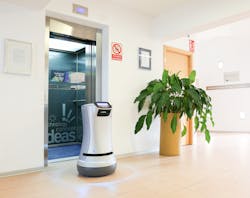Today’s businesses are embracing the opportunity to evolve. And as a result, the use of smart technology is expanding at phenomenal rates.
According to a report by Mordor Intelligence, the smart factory market was valued at USD $230.99 billion in 2018, and it is expected to reach USD $391.29 billion by 2024, at a CAGR of 9.22% during the forecast period. Likewise, according to Marketwatch, the smart building market is expected to reach USD $79 billion by 2025 – a growth rate of more than 33.8% over the forecast period 2018-2025.
Both trends are significant as organizations look for innovative new ways to capitalize on new data-driven capabilities to better create products that today’s consumers actually want.
Of course, layers of connectivity are crucial within smart environments in order to avoid having a bunch of cool pieces of technology each operating within self-imposed silos.
Going down?
The lack of connectivity between robots and elevators is a prime example – ultimately limiting the effectiveness of these dynamic tools.
Thyssenkrupp Elevator has solved this disconnect by creating a dynamic interface between elevators and robots. “We have set up a standard interface for communications between elevators and robot,” says Jon Clarine, head of digital services for thyssenkrupp Elevator. “The integration of hardware and software enables robots from various manufacturers to leverage Wi-fi to wirelessly place a call to an elevator. This is crucial since most office robots do not have arms or fingers.”
Development challenges
Overcoming the obstacles of creating a solution that could work seamless with an array of proprietary programming interface was only part off the challenge. Thyssenkrupp’s development team spent significant time addressing the issues of what it means for a to become a rider. This includes how it enters the elevator. For instance, a robot cannot intuitively anticipate where to stand. In addition, most delivery robots do not all have eyes or cameras so they cannot identify when the doors are open. And, to avoid any interference between other smart systems, thyssenkrupp programmed the protocol so that only the robot and elevator understand the communication.
“For this to work we needed to think through the things that the robot does not know and program that into the elevator,” says Clarine. “We needed to create a connection where the two technologies could together as one unit without disrupting the traffic or flow of the building.
When thyssenkrupp first started working on developing this offering, the barrier of entry for a lot of robot companies had been elevator interaction, explains Clarine. “As wireless technology and cloud capabilities have improved, significant investment has gone into this space with a focus on bringing the cost of robots down,” he says. “Robots are practical solution providers and the connection with robots is allowing them to scale in usability across an array of environments and applications (such as delivering parts in production facilities or medicine in hospitals).”
About the Author
Peter Fretty
Technology Editor
As a highly experienced journalist, Peter Fretty regularly covers advances in manufacturing, information technology, and software. He has written thousands of feature articles, cover stories, and white papers for an assortment of trade journals, business publications, and consumer magazines.

